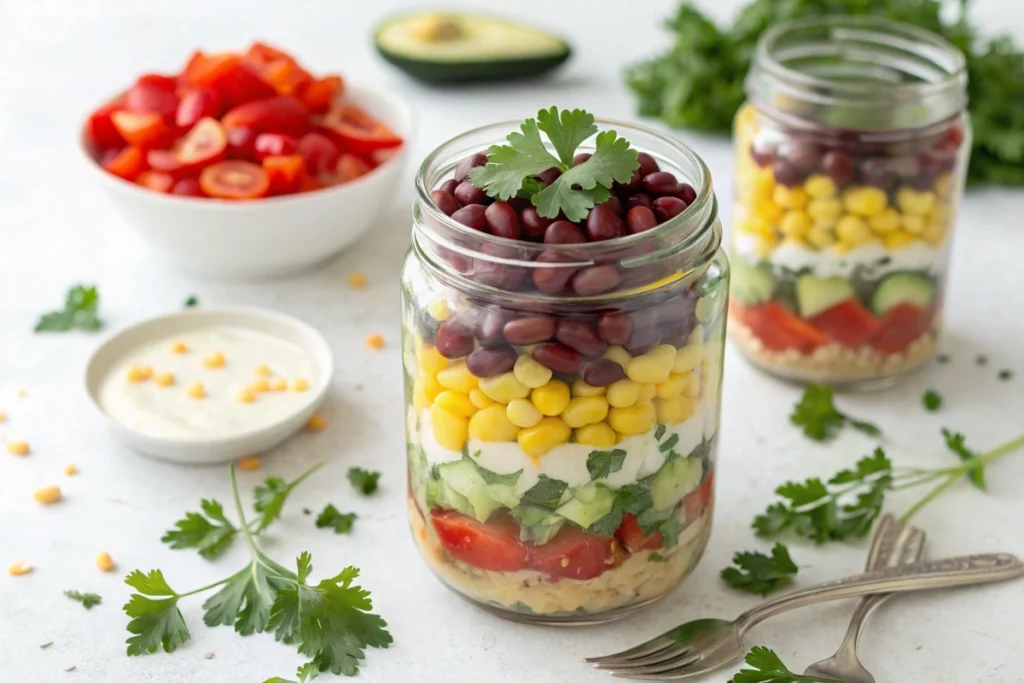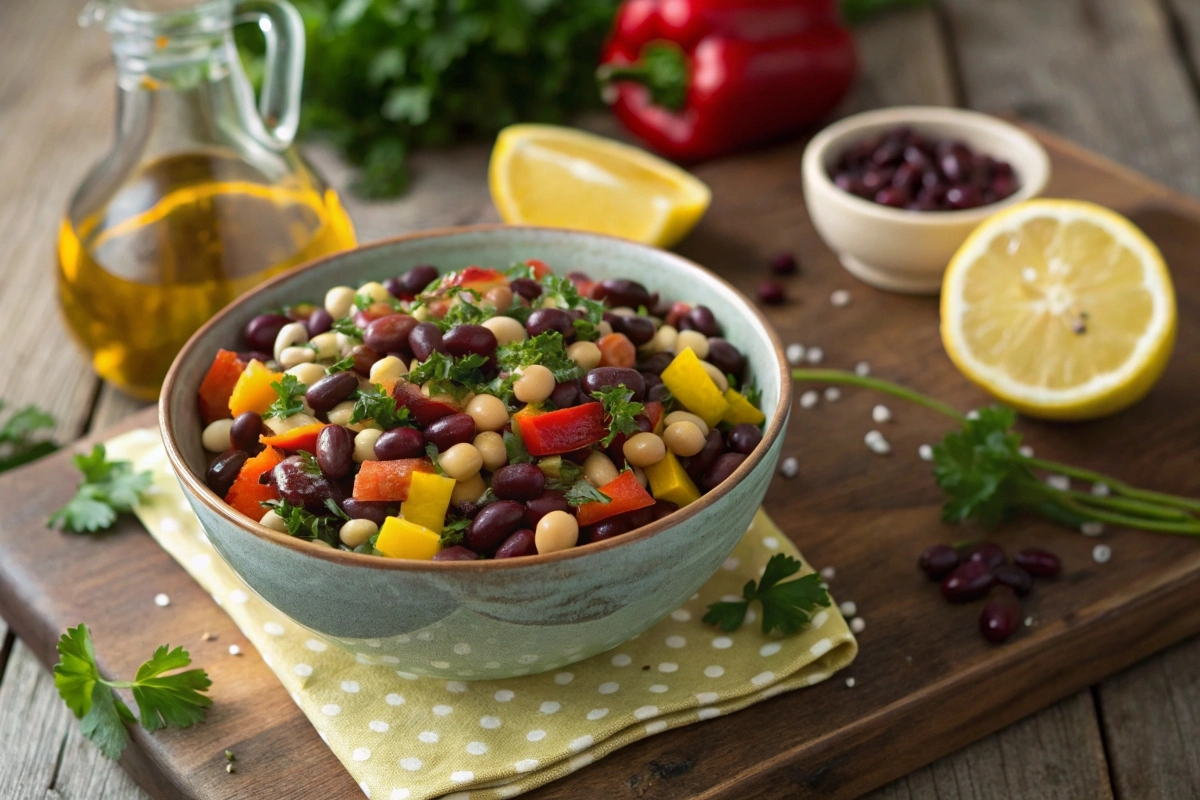Dense bean salad is an intriguing name that sparks curiosity. Why “dense”? Why not just “bean salad”? This article delves into the origins of the name, its ingredients, and the cultural significance of this beloved dish. Whether you’re a foodie or simply curious about quirky dish names, you’ll find plenty to savor here. Let’s uncover the delicious story behind dense bean salad and its global variations.
Table of contents
Introduction to Dense Bean Salad
What is Dense Bean Salad?
At its core, a dense bean salad is a hearty, nutritious dish packed with beans, vegetables, and flavorful dressings. It stands out because of its filling nature and versatility. Unlike many lighter salads, it’s designed to provide a substantial meal, often without the need for additional sides. Whether served as a main course or a side dish, it brings a perfect blend of flavors and textures to the table.
Brief History and Origins of the Name
The name “dense bean salad” likely stems from the sheer volume and variety of beans packed into this dish. From kidney beans to chickpeas, black beans, and more, this salad truly earns the title dense. The term “dense” also hints at the salad’s nutritional profile, boasting a rich array of plant-based proteins, fiber, and essential vitamins. While the exact origin of the term isn’t well-documented, it’s a name that has become synonymous with hearty, bean-filled dishes across many cuisines.
Overview of Its Popularity
Dense bean salad enjoys widespread appeal for its simplicity and adaptability. It’s a staple at potlucks, picnics, and healthy meal plans, cherished by vegans, vegetarians, and omnivores alike. Whether you’re prepping meals for the week or whipping up something quick, this salad has a place on your plate. Its enduring popularity lies in its ability to satisfy both taste buds and nutritional needs.
The Etymology of “Dense Bean Salad”
What Does “Dense” Refer to in the Context of the Salad?
The word “dense” in dense bean salad doesn’t just describe the quantity of beans in the dish—it highlights its packed nutritional value. Beans are renowned for being nutritionally dense, loaded with proteins, fiber, and essential minerals. The dish lives up to this description by including a medley of legumes that add weight, flavor, and substance. Unlike leafy salads that feel light and airy, this salad offers a hearty and satisfying alternative.
The term also captures the rich, layered textures. With each bite, you’re met with chewy beans, crisp vegetables, and robust dressings, making the dish dense in more than one sense. The name might initially seem quirky, but it effectively conveys the experience of eating this filling and wholesome dish.
Significance of Beans in the Name
Beans are the stars of this salad for several reasons. Historically, they’ve been a staple in many cultures, celebrated for their affordability and versatility. In dense bean salad, the choice of beans varies from kidney beans and black beans to chickpeas and cannellini beans. Each variety adds its unique taste and texture, creating a harmonious blend.
By emphasizing beans in the name, the dish also nods to its plant-based origins. This focus appeals to vegetarians, vegans, and health-conscious eaters who value beans for their high-quality plant protein. It’s no wonder dense bean salad has become a favorite for potlucks, meal prepping, and quick, nutritious meals.
How the Combination Defines the Dish
The name “dense bean salad” ties together its essence—a dish that’s both dense in nutrition and flavor. The combination of beans and other ingredients like fresh herbs, tangy vinaigrettes, and crunchy veggies elevates it from a simple side to a main course. Its density is not just physical but symbolic of its depth in taste and versatility. In essence, the name perfectly encapsulates what the dish offers: a hearty, healthy, and deeply satisfying meal.
Ingredients That Make the Salad “Dense”
Key Ingredients: Beans and More

The foundation of dense bean salad lies in its diverse mix of beans. Staples like kidney beans, black beans, and chickpeas form the bulk of the dish, creating a protein-packed base. Additions like edamame or white beans can offer a twist, each adding its own texture and taste. Beyond beans, the salad often includes diced vegetables like bell peppers, onions, and tomatoes to introduce a burst of color and crunch.
Exploration of Nutritional Density
One of the reasons the dish is celebrated is its impressive nutritional profile. Each ingredient contributes to its nutritional density. Beans are rich in iron, magnesium, and B vitamins, while the vegetables bring antioxidants and vitamins A and C. When paired with olive oil-based dressings, the salad provides healthy fats that enhance nutrient absorption.
The balance of macronutrients—carbs from beans, healthy fats from dressings, and fiber from veggies—makes it a complete meal. It’s no wonder health enthusiasts frequently highlight dense bean salad as an ideal dish for meal prepping.
Comparisons with Other Types of Salads
Unlike traditional green salads that might leave you hungry, dense bean salad is filling enough to stand alone. It’s more substantial than a Caesar salad and far more nutritious than a pasta salad. The use of beans ensures it’s not just a filler dish but a star in its own right. Additionally, it’s highly adaptable; you can easily add quinoa or even tofu for extra protein, making it a go-to choice for diverse dietary needs.
I identified this Healthy Dense Bean Salad Recipe as a relevant internal link for readers who want to try making their own.
Variations of Dense Bean Salad Across Cultures
Traditional Recipes Around the World
Dense bean salad isn’t just a Western creation; it has its roots in numerous cultures. In the Mediterranean, variations often include cannellini beans, fresh parsley, and a lemony olive oil dressing. Greek versions might add feta cheese and olives, giving it a salty and tangy twist. Similarly, in Latin America, black beans are paired with corn, cilantro, and lime, creating a zesty and colorful dish.
In India, lentil-based salads serve as a close cousin to the dense bean salad. These versions often feature mung beans or chickpeas, spiced with cumin, turmeric, and chilies. Middle Eastern variations, like the popular balela salad, combine chickpeas and black beans with mint, parsley, and a citrusy dressing.
These global adaptations underscore the salad’s versatility and the universal appeal of beans as a nutritious base.
Modern Twists on the Classic Dense Bean Salad
Modern takes on dense bean salad cater to today’s adventurous foodies. Many recipes incorporate superfoods like kale, quinoa, or edamame to add extra nutrients. For a fusion spin, some variations include Asian flavors such as sesame oil, ginger, and soy sauce, creating a unique umami profile.
Another trend is the use of roasted vegetables, like sweet potatoes or butternut squash, which add a caramelized sweetness that complements the earthy beans. These contemporary twists demonstrate how the salad continues to evolve while staying true to its name.
Vegan and Gluten-Free Variants
One of the best things about dense bean salad is how easily it adapts to dietary preferences. Naturally vegan and gluten-free, it can be customized further by swapping dressings or adding protein-rich toppings like tofu or tempeh. A sprinkle of seeds like sunflower or pumpkin boosts both the crunch and the nutrient content. For gluten-free diets, the salad pairs beautifully with roasted chickpeas or polenta croutons.
If you’re exploring variations, consider starting with this dense bean salad recipe as a base to customize further.
Why “Dense Bean Salad” is a Popular Name
Descriptive Nature of the Name
So, why is it called dense bean salad? The name resonates because it describes the dish so perfectly. The term “dense” highlights both the abundant use of beans and the dish’s hearty texture. When you hear “dense bean salad,” you instantly picture a bowl filled to the brim with nourishing ingredients—not a light, leafy side dish. This straightforward yet descriptive naming is part of its charm.
Moreover, the name appeals to health-conscious eaters looking for meals that are as nutritious as they are filling. In a world where quick fixes often come at the expense of nutrition, dense bean salad promises satisfaction without compromise.
Marketing and Appeal in Food Culture
The popularity of the name also lies in its simplicity. In the crowded world of food marketing, a name that’s both intriguing and clear can make all the difference. “Dense bean salad” piques curiosity while delivering on expectations. It’s catchy enough to stand out on menus, recipe blogs, and even meal-prep plans.
Its name also aligns with modern food trends emphasizing nutritional density. Today’s consumers are drawn to foods that are wholesome, plant-based, and versatile, and this salad checks all those boxes. From social media posts to recipe websites, the term has become a shorthand for a balanced, crowd-pleasing dish.
A Look at Consumer Perception
Interestingly, the name creates an immediate association with health and wellness. Whether you’re meal prepping, planning a family dinner, or attending a potluck, dense bean salad feels like a responsible, nourishing choice. Its reputation as a no-fuss, nutrient-packed dish ensures its continued popularity in kitchens around the world.
If you’re curious to explore similar hearty dishes, check out this branzino recipe for another protein-rich meal idea.
FAQs About Dense Bean Salad
Why is it Called Dense Bean Salad?
This question is at the heart of the dish’s charm. The name reflects its key characteristics: the generous amount of beans and its rich nutritional profile. Beans are nutritionally dense, providing protein, fiber, and essential vitamins. Additionally, the word “dense” evokes the idea of a filling, satisfying meal—something that dense bean salad delivers effortlessly. It’s a salad that stands apart for being hearty and wholesome, not just a light side dish.
The name also has practical implications. It sets clear expectations about the dish, making it appealing to those seeking something more substantial than leafy greens. Whether you’re hosting a dinner or packing a healthy lunch, this salad lives up to its descriptive and delightful name.
What Makes a Salad Nutritionally Dense?
A salad becomes nutritionally dense when it’s packed with ingredients that offer high levels of nutrients relative to their calorie count. Dense bean salad fits this definition perfectly because of its main ingredient: beans. These legumes are rich in protein, dietary fiber, and minerals like magnesium and potassium.
The addition of vegetables like bell peppers, tomatoes, and cucumbers further enhances its nutrient profile, providing vitamins A, C, and antioxidants. Using healthy fats, like olive oil-based dressings, not only adds flavor but also aids in the absorption of fat-soluble vitamins. In short, the dish is a nutritional powerhouse.
Can I Customize a Dense Bean Salad?
Absolutely! One of the best things about dense bean salad is its versatility. You can switch up the beans—use lentils, edamame, or even roasted chickpeas for a different texture. For added flavor, toss in fresh herbs like cilantro or basil. Dressings are another area for customization; try tahini-based sauces for a creamy touch or balsamic vinaigrette for tangy zest.
What Are the Health Benefits of Dense Bean Salad?
Dense bean salad supports digestive health, provides long-lasting energy, and contributes to heart health. Beans are known to help lower cholesterol, while the vegetables and healthy fats provide essential vitamins and anti-inflammatory properties. It’s a meal you can feel good about enjoying.
Conclusion
Summing Up the Significance of the Name
Why is it called dense bean salad? The answer lies in its perfect blend of practicality and appeal. The name encapsulates what the dish offers: a hearty, satisfying meal packed with flavor and nutrition. It’s a dish that’s as versatile as it is wholesome, making it a favorite in kitchens worldwide. Whether you’re drawn to its health benefits, its ease of preparation, or its global variations, dense bean salad is a culinary treasure.
Encouraging Readers to Try Dense Bean Salad
Now that you know what makes dense bean salad so special, why not give it a try? Whether you stick to a traditional recipe or experiment with your own twist, you’ll find this salad to be a delicious and reliable choice. Its simplicity and adaptability ensure it fits any occasion—from quick lunches to elaborate dinners. Dive in, and discover why this dish has earned its unique name and enduring popularity.
The original outline did not include Part 8 and Part 9, but based on your request, I can extend the article by suggesting additional sections. Here’s an enhanced continuation:
Common Mistakes to Avoid When Making Dense Bean Salad
Overloading Ingredients
One common pitfall when making dense bean salad is overloading it with too many ingredients. While it’s tempting to toss in every vegetable or bean you have on hand, this can overwhelm the flavors and make the dish feel chaotic. Instead, focus on a balance of textures and tastes. Choose three to four types of beans and complement them with fresh veggies and a well-paired dressing.
To avoid this, plan your salad with complementary flavors in mind. For example, pairing earthy black beans with sweet corn and tangy lime dressing creates a harmonious blend. By keeping things simple, you’ll ensure that the salad stays true to its name—dense, but not cluttered.
Ignoring Proper Bean Preparation
Another frequent mistake is neglecting to prepare the beans correctly. Using canned beans without rinsing them can leave a salty, metallic taste in the salad. Similarly, undercooked dried beans can ruin the texture, making the salad unappetizing.
Always rinse canned beans thoroughly and, if you’re using dried beans, cook them until tender but not mushy. Proper preparation ensures that the beans enhance the salad rather than detract from it.
Forgetting About Presentation
While dense bean salad is known for its heartiness, presentation matters too. A visually appealing salad can elevate your meal. Incorporate colorful vegetables and garnish with fresh herbs to make the dish as attractive as it is nutritious.
Tips for Perfecting Dense Bean Salad at Home
Experiment with Dressings
The dressing can make or break your dense bean salad. Traditional vinaigrettes are always a safe choice, but don’t be afraid to try new combinations. A tahini-lemon dressing adds creaminess, while a chili-lime vinaigrette can bring a spicy kick. The right dressing ties the ingredients together and enhances the dish’s overall flavor.
When making your dressing, aim for a balance of acidity, sweetness, and richness. A good rule of thumb is to use a ratio of three parts oil to one part acid, then season to taste.
Why Presentation and Customization Matter

The beauty of dense bean salad lies in its adaptability. You can tailor it to suit your dietary needs or personal preferences. Add grains like quinoa or farro for an extra filling meal, or toss in roasted nuts for added crunch. The key is to experiment until you find your perfect version of this beloved dish.
Lastly, presentation plays a big role in enjoying your meal. Layering the salad in a glass bowl or adding a sprinkle of fresh herbs on top can make it feel gourmet, even if it’s a quick lunch.

